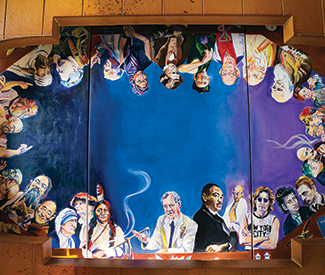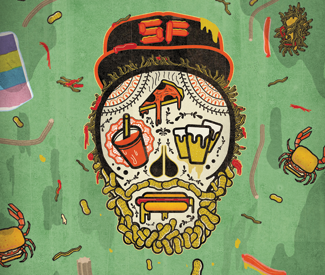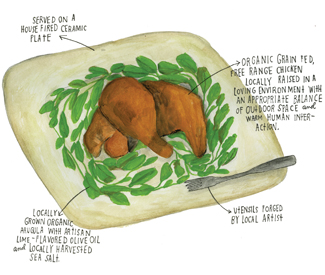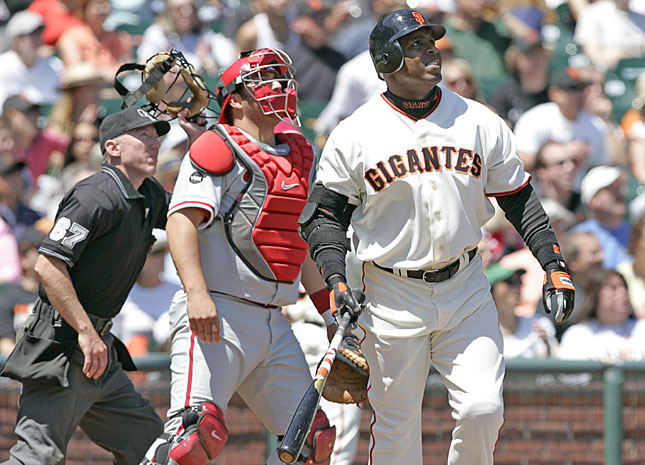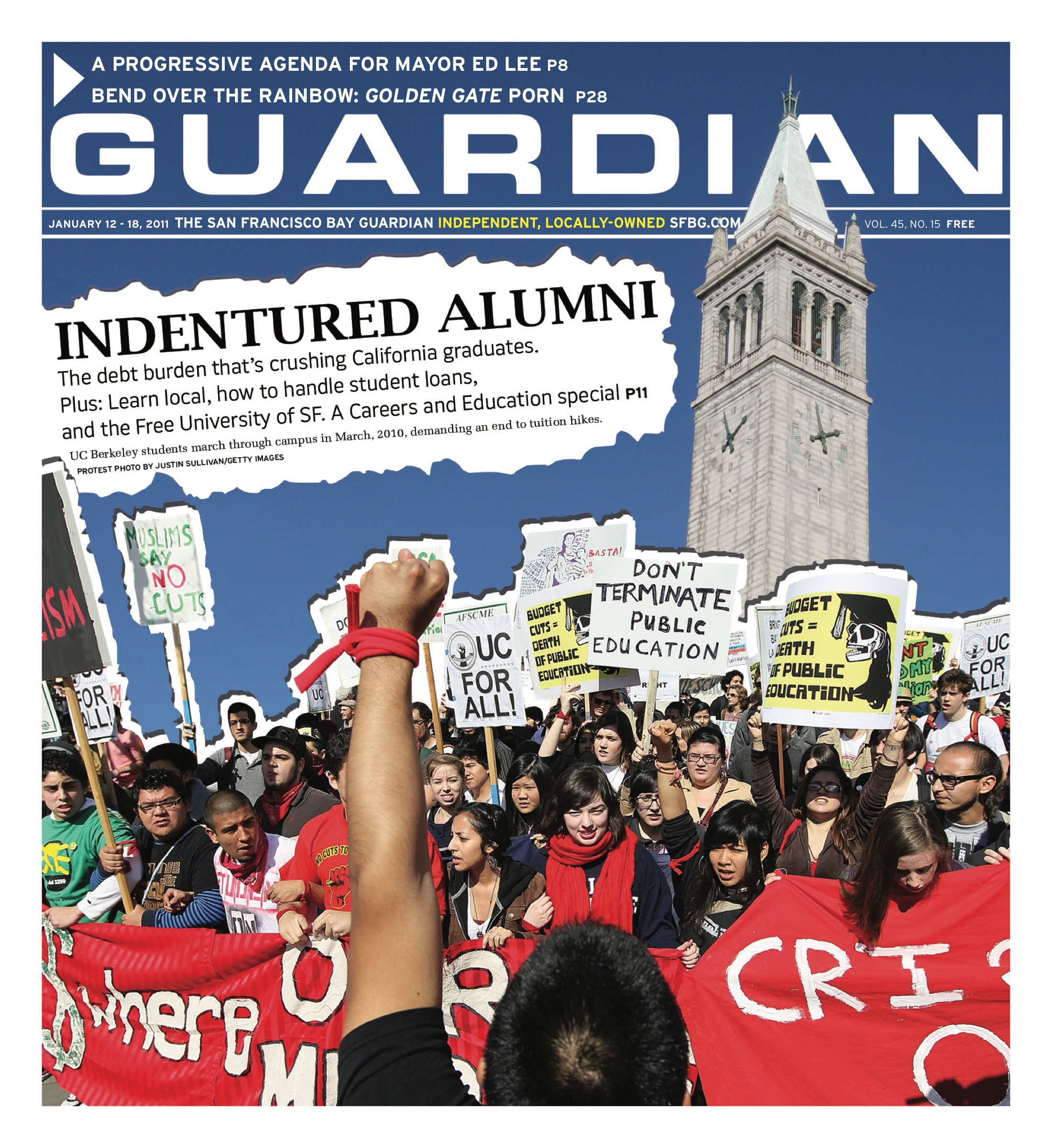Performance times may change; call venues to confirm. Reviewers are Robert Avila, Rita Felciano, and Nicole Gluckstern. Submit items for the listings at listings@sfbg.com. For further information on how to submit items for the listings, see Picks.
THEATER
OPENING
The Golden Girls: The Christmas Episodes Victoria Theatre, 2961 16th St, SF; www.trannyshack.com. $30. Opens Thu/6, 8pm. Runs Thu-Sat, 8pm; Sun, 7pm. Through Dec 30. Four drag queens + The Golden Girls + Christmas = holiday magic.
Hedwig and the Angry Inch Boxcar Playhouse, 505 Natoma, SF; www.boxcartheatre.org. $25-35. Opens Wed/5, 8pm. Runs Wed-Sat, 8pm (also Sat, 5pm). Through Jan 26. Boxcar’s popular production of John Cameron Mitchell’s glam-rock musical returns, starring a rotating cast of Hedwigs.
"A Minor Cycle: Five Little Plays in One Starry Night" NOHspace, Project Artaud, 2840 Mariposa, SF; www.theatreofyugen.org. $10-30. Previews Tue/11, 7pm. Opens Wed/12, 7pm. Runs Wed-Thu, 7pm; Fri-Sat, 8pm; Sun, 1pm. Through Dec 30. Theatre of Yugen presents the world premiere of five one-act plays based on tales of childhood, interpreted though traditional Japanese artistry.
"The San Francisco Olympians Festival" Exit Theater, 156 Eddy, SF; www.sfolympians.com. $10. Opens Wed/5, 8pm. Runs Wed-Sat, 8pm (also Sat, 2pm). Through Dec 20. This 12-night festival features brand-new plays by Bay Area writers, each based on one of the 12 Olympian gods of ancient Greece.
ONGOING
A Christmas Carol Geary Theater, 415 Geary, SF; www.act-sf.org. $20-95. Tue-Sat, 7pm (no evening performance Thu/6, Tue/11, or Dec 18; also 2pm matinees Sat/8, Dec 12, 15, 21, and 22; Sun, 5:30pm (also 1pm matinees Sun/9, Dec 16, and 23); Dec 24, 1pm. Through Dec 24. American Conservatory Theater’s annual holiday performance features James Carpenter as Scrooge.
Foodies! The Musical Shelton Theater, 533 Sutter, SF; www.foodiesthemusical.com. $30-34. Fri-Sat, 8pm. Open-ended. AWAT Productions presents Morris Bobrow’s musical comedy revue all about food.
History: The Musical Un-Scripted Theater, 533 Sutter, SF; www.un-scripted.com. $10-20. Thu-Sat, 8pm. Through Dec 22. The Un-Scripted Theater Company performs "an unscripted romp through Western history."
Hysterical, Historical San Francisco: Holiday Edition Alcove Theater, 414 Mason, Ste 502, SF; www.thealcovetheater.com. $25-40. Fri-Sat and Dec 26-31, 9pm. Through Dec 31. Comedian Kurt Weitzmann takes on San Francisco history, adding some holiday flair along the way.
The Marvelous Wonderettes New Conservatory Theatre Center, 25 Van Ness, SF; www.nctcsf.org. $27-46. Previews Wed/5-Fri/7, 8pm. Opens Sat/8, 8pm. Runs Wed-Sat, 8pm; Sun, 2pm (no show Dec 23). Through Jan 13. New Conservatory Theatre Center performs Roger Bean’s 1950s pop-hit musical.
The New California Traveling Jewish Theater, 470 Florida, SF; www.pianofight.com. $20-25. Wed, 8pm. Through Dec 19. PianoFight Productions’ female-centric sketch comedy group ForePlays presents an all-new variety show.
Open Shotwell Studios, 3252 19th St, SF; www.brownpapertickets.com. $20. Fri-Sat and Mon, 8pm. Through Dec 17. A married couple decides to open up their relationship in Back Alley Theater and Footloose’s production of Jeff Bedillion’s comedy for mature audiences.
Pal Joey Eureka Theatre, 215 Jackson, SF; www.42ndstreetmoon.org. $25-75. Wed, 7pm; Thu-Fri, 8pm; Sat, 6pm; Sun, 3pm. Through Dec 16. 42nd Street Moon performs the Rodgers and Hart classic.
The Rainmaker Shelton Theater, 533 Sutter, SF; www.sheltontheater.org. $38. Fri-Sat, 8pm. Through Dec 22. Shelton Theatre preforms N. Richard Nash’s classic drama.
Slugs and Kicks Thick House, 1695 18th St, SF; www.therhino.org. $15-30. Wed/5-Sat/8, 8pm; Sun/9, 3pm. In Theatre Rhinoceros’ new coming-of-age comedy from admired playwright-director John Fisher (Medea: The Musical, Fighting Mac!), Rory (Ben Calabrese) is a high-strung but affable 20-year-old virgin studying acting at Purgatoria State University in the 1980s, where he admits (in his own simultaneous but retrospective narration), "I learned all I needed to know about life." The lessons unfold in the course of a senior thesis play directed by its author, a bitchy boozy queen named Jerry (a sharp Zachary Isen) who hires Rory for a bit part and Rory’s friend and roommate Anis (Alexandra Izdebski) for the lead. Anis plays opposite Rory’s nemesis, Giles (Nicholas Trengove), a muscle-bound happy-go-lucky bloke who can’t bother to memorize his lines but gets called a good actor anyway because he’s English. Anis soon turns her frustrated affections for the timid Rory (who insists he’s not gay, a little too often to be believed) to the eager Giles. Rory, in turn, accepts the advances of Giles’ jilted but equally unconcerned girlfriend, Cynthia (Asali Echols), while also spending increasingly quality time with his other roommate Marty (Robert Kittler), a loquacious class-conscious stoner who enjoys excursions along the more formidable socioeconomic borders of the city. The newfound attention goes to Rory’s head, and guilt and bad behavior (tied ultimately to an aloof father) ensue amid backstage machinations that leave Rory, among other things, bereft of that annoying late-term virginity. But nothing ever too terrible happens. This is a gentle story — sparingly staged and rooted in lightly shaded, humor-laden nostalgia — with a gentle message about letting go of extraneous, socially oppressive categories and freeing up the self. If you learn that in college, virgin or no, you’re probably ahead of the curve. (Avila)
Speed-the-Plow Actors Theatre of San Francisco, 855 Bush, SF; www.actorstheatresf.org. $26-38. Wed-Sat, 8pm. Extended through Dec 21. Actors Theatre of San Francisco performs the David Mamet drama.
The Submission New Conservatory Theatre Center, 25 Van Ness, SF; www.nctcsf.org. $25-45. Wed-Sat, 8pm; Sun, 2pm. Through Dec 16. New Conservatory Theatre Center performs Jeff Talbott’s drama about a playwright who falsifies his identity when he enters his latest work into a prestigious theater festival.
The Waiting Period Marsh San Francisco, 1062 Valencia, SF; www.themarsh.org. $15-50. Thu/6-Fri/7, 8pm; Sat/8, 5pm. Brian Copeland (comedian, TV and radio personality, and creator-performer of the long-running solo play Not a Genuine Black Man) returns to the Marsh with a new solo, this one based on more recent and messier events in Copeland’s life. It’s a worthy aim but only a fitfully engaging piece, since as drama it remains thin, standing at perhaps too respectful a distance from the convoluted torment and alienation at its center. (Avila)
BAY AREA
Acid Test: The Many Incarnations of Ram Dass Marsh Berkeley, 2120 Allston, Berk; www.themarsh.org. $15-50. Thu-Fri, 8pm; Sat, 5pm. Extended through Jan 5. Lynne Kaufman’s new play stars Warren David Keith as the noted spiritual figure.
Big River TheatreWorks, 1305 Middlefield, Palo Alto; www.theatreworks.org. $23-73. Tue-Wed, 7:30pm; Thu-Sat, 8pm (also Sat, 2pm); Sun, 2 and 7pm. Through Dec 30. TheatreWorks performs the Tony-winning musical based on Mark Twain’s Huck Finn stories.
Dracula Berkeley Community Church, 1802 Fairview, Berk; www.infernotheatre.org. $12-25. Thu and Sat-Sun, 8pm; Fri, 9pm. Though Dec 16. Inferno Theatre Company performs Giulio Cesare Perrone’s adaptation of the Bram Stoker classic.
It’s a Wonderful Life: A Live Radio Play Marin Theatre Company, 397 Miller, Mill Valley; www.marintheatre.org. $36-57. Tue and Thu-Sat, 8pm (also Thu/6, 1pm; Dec 15, 2pm); Wed, 7:30pm; Sun, 2 and 7pm. Through Dec 16. Marin Theatre Company performs Joe Landry’s live radio play adaptation of the classic Capra film.
The Kipling Hotel: True Misadventures of the Electric Pink ’80s Marsh Berkeley, 2120 Allston, Berk; www.themarsh.org. $20-50. Sat, 8:30pm; Sun, 7pm. Extended through Dec 16. This new autobiographical solo show by Don Reed, writer-performer of the fine and long-running East 14th, is another slice of the artist’s journey from 1970s Oakland ghetto to comedy-circuit respectability. Even with some awkward bumps along the way, it’s never a dull thing watching Reed work. (Avila)
Toil and Trouble La Val’s Subterranean, 1834 Euclid, Berk; www.impacttheatre.com. $10-20. Thu/6-Sat/8, 8pm. For a theater company known for its radical interpretations of the Shakespearean canon, a play such as Lauren Gunderson’s Toil and Trouble, a goofy Generation Why retelling of Macbeth, is a particularly good fit for Impact Theatre. Whittled down to a dynamic three-character chamber play featuring delusionary slackers plotting to turn their MBAs and nebulous SF Giants connections into a bloodless takeover of a remote island nation rather than get crappy café jobs to pay the rent, Toil throws baseball, investors, Wikipedia, fortune cookies, hypothetical sex, and real violence into one cauldron, letting them bubble and froth throughout the piece. The so-crazy-it-might-just-work plan hatched by Adam (Michael Delaney), a relentlessly cheerful narcissist, quickly leads to tension between the three, especially once the potential payout is estimated at 30 million dollars, and before their plot is even finalized, a tenuous, murderous alliance forms between the insufferably wimpy Matt (Will Hand) and the rage-aholic Beth (Jeanette Penley). All three actors play their all-too-familiar characters to the hilt, and Josh Costello’s direction is deft and assured. A surprise twist subverts the expected lull of tragedy, and all is resolved, more or less, in a manner more appropriate to this time and place than Shakespeare’s, though not without some grand sound and fury beforehand, signifying both. (Gluckstern)
The White Snake Berkeley Repertory Theatre, Roda Theatre, 2025 Addison, Berk; www.berkeleyrep.org. $29-99. Tue and Thu-Sat, 8pm (also Sat and Dec 13, 2pm); Sun, 2 and 7pm. Through Dec 23. In Mary Zimmerman’s The White Snake, nothing is quite as it seems. A mysterious stranger and her faithful servant are, in reality, a pair of shape-shifting serpents, the humble village pharmacy they build (with stolen money) is a front for their magical healing powers, a venerated Buddhist Abbott is actually a small-minded tyrant with a remarkably unholy obsession. Based on a Chinese myth dating to the 10th century, elements of "The White Snake" can be found in other mythologies around the world — from the biblical tempter in the Garden of Eden, to the healer snakes of Asclepius. However, in accordance with the tale’s historical evolution, from horror story to romance, Zimmerman’s treatment focuses mainly on the unusual love affair between Madame White (Amy Kim Waschke) and her karma-selected husband Xu Xian (Christopher Livingston). Weaving together fanciful design (a rainfall of ribbons, parasol puppetry, elegant period costuming and evocative video), elements of Chinese drama (amusingly described by narrators as they take place on stage), and a stirring reflection on the transformative power of love, complete with themes of self-sacrifice and endless fidelity, The White Snake, is a delicately-rendered fairytale which may not offer a way to enlightenment, but certainly clears a path to the heart. (Gluckstern)
Wilder Times Aurora Theatre, 2081 Addison, Berk; www.auroratheatre.org. $32-60. Wed/5-Sat/8, 8pm; Sun/9, 2 and 7pm. Aurora Theatre performs a collection of one-acts by Thornton Wilder.
Woyzeck Ashby Stage, 1901 Ashby, Berk; www.shotgunplayers.org. $23-35. Previews Wed/5-Thu/6, 7pm. Opens Fri/7, 8pm. Runs Wed-Thu, 7pm; Fri-Sat, 8pm; Sun, 5pm. Through Jan 27. Shotgun Players presents Tom Waits, Kathleen Brennan, and Robert Wilson’s tragic musical, based on an unfinished 1837 play by Georg Büchner.
PERFORMANCE/DANCE
BATS Improv Bayfront Theater, B350 Fort Mason Center, SF; www.improv.org. $20. "Theatresports," Fri, 8pm, through Dec 21.
"Beyond the Land of the Sweets" Herbst Theatre, 401 Van Ness, SF; www.presidiodance.org. Sun/9, 5pm, $35-50. Presidio Dance Theatre performs a multicultural, Nutcracker-inspired show.
"The Buddy Club Children’s Shows" Randall Museum Theater, 199 Museum Wy, SF; www.thebuddyclub.com. Sun/9, 11am-noon. $8. Body percussion, physical comedy, and juggling with Unique Derique.
"The Business" Dark Room Theater, 2263 Mission, SF; www.darkroomsf.com. Wed/5, 9pm. $5. Comedy with Derek Sheen.
"Comedy Bottle" Purple Onion at Kells, 530 Jackson, SF; www.thepurpleonionatkells.com. Fri/7-Sat/8, 8:30pm. $15. Stand-up with Ali Mafi, Debbie Campo, and Lydia Popovich.
"Comedy Returns to El Rio!" El Rio, 3158 Mission, SF; www.koshercomedy.com. Mon/10, 8pm. $7-20. With Dan St. Paul, Yayne Abeba, Kurt Weitzmann, Justin Lucas, and Lisa Geduldig.
"Cynic Cave" Cinecave (beneath Lost Weekend Video), 1034 Valencia, SF; facebook.com/cyniccave. $10. "Talkies: Holiday-Themed Show," multimedia show of holiday-themed comedy with DJ Real, Caitlin Gill, Sean Keane, and more, Fri/7, 7:30pm. "Cynic Cave," stand-up comedy with Mike Drucker, Kevin Camia, Marga Gomez, and more, Sat/8, 7:30pm.
"Dance-Along Nutcracker Goes Hollywood!" Yerba Buena Center for the Arts, 701 Mission, SF; www.dancealongnutcracker.org. Sat/8, 2:30 and 7pm (7pm show, "Grownups Only Gala"); Sun/9, 1pm. $16-50. The San Francisco Lesbian/Gay Freedom Band presents its popular annual spin on the holiday classic.
"Drag Queens on Ice: Bigger! Better! Bawdier" Safeway Holiday Ice Rink, Union Square, Powell at Geary, SF; www.unionsquareicerink.com. Thu/6, 8-9:30pm. Free with admission ($6-$10) and skate rental ($5). Big hair takes the ice when Donna Sachet hosts this night of skating with Bay Area drag queens and kings.
"Hella Gay All Stars Comedy Show" Stage Werx Theater, 446 Valencia, SF; ww.stagewerx.org. Fri/7, 7:30pm. $5. Charlie Ballard hosts this night of stand-up, featuring Kate Willett, Loren Kraut, Shanti Charan, and more.
"Help is on the Way for the Holidays XI" Marines Memorial Theatre, 609 Sutter, SF; www.helpisontheway.org. Mon/10, 7:30pm. $40-60. Shanti and Broadway Cares/Equity Fights AIDS benefit from this concert, feauring Mary Wilson, jazz singers Paula West and Tim Hockenberry, cast members from the touring productions of The Lion King and The Book of Mormon, and more.
"Instrument" CounterPULSE, 1310 Mission, SF; www.counterpulse.org. Thu/6-Sun/9, 8pm. $15-20. A polymorphous individuality pertains to Instrument, a new solo dance-performance by Monique Jenkinson, which encompasses original choreography by Jenkinson and three other notable and very distinct artists — SF-based Chris Black, New York–based Miguel Gutierrez, and SF-based Amy Seiwert. It’s an intriguing departure for the dancer and performance maker best known for her endeavors at the forefront of the drag idiom (under the stage name Fauxnique). In the end, Jenkinson’s audacious venture (co-presented by CounterPULSE, de Young Museum, and Dancers’ Group) is both something more than a solo and less than a complete (or completely satisfying) work. Circling around her lifelong devotion to ballet and the ambivalent memories and associations it generates, the piece as edited by Jenkinson comes bracketed by an at times self-conscious, at times rapturous embrace of balletic form. But throughout come dissonances, departures, ruptures, and spoken ruminations that cross a wide swath of contemporary dance. The artist’s focused and untiring ability to zigzag through it all is something to see and admire, and the refraction of the body/self through so many lenses suggests a promising opportunity for exploration. Yet, while exploiting the potential flagged by the title is certainly part of the point, the erratic design generates a stiflingly formal rhythm and quality. Each modulation is too abbreviated (and of varying merit) to make the whole feel like much more than an exercise (at least much of the time). Moreover, the approach proves unproductively at odds with the autobiographical through-line, which ends up rather thin and sentimental. You can’t help feeling that if the better and riskier moments (many of which seem to have come from Gutierrez) had been sustained and elaborated, the self-reflective aspect would have given way to some quicksand in which the self risked a kind of creative obliteration. That frontier gets tantalizingly close at times, looming in the near distance. (Avila)
"The Not-the-Messiah December Choral Concert" St. Mark’s Lutheran, 1111 O’Farrell, SF; www.voltisf.org. Fri/7, 8pm. Also Sat/8, 8pm, David Brower Center, 2150 Allston, Berk. Both shows $30. Volti performs alternative holiday songs, including new works by Puerto Rican composter Armando Bayolo.
"Nutcracker" Palace of Fine Arts Theater, 3301 Lyon, SF; www.cityboxoffice.com. Sat/8-Sun/9, 2pm (also Sat/8, 7pm). $25-35. City Ballet School performs its 10th annual Nutcracker, featuring student dancers ages 6-19.
San Francisco Comedy College Purple Onion at Kells, 530 Jackson, SF; www.sfcomedycollege.com. $5-15; all shows ongoing. "Laughter Hour," Thu-Fri, 7pm. "Destini and Yonatan’s Stand-Up Rebellion," Thu, 8:30. "Comedy Bottle," Fri-Sat, 8:30pm. "Kells Comedy Saturday," Sat, 7pm. "New Talent Shows," Tue-Wed, 7. Also Larkspur Hotel, 524 Sutter, SF. "Rocket Salad," Sun, 7.
"San Francisco Magic Parlor" Chancellor Hotel Union Square, 433 Powell, SF; www.sfmagicparlor.com. Thu-Sat, 8pm. Ongoing. $40. Magic vignettes with conjurer and storyteller Walt Anthony.
"SantaConCert" Davies Symphony Hall, 201 Van Ness, SF; www.sfgmc.org. Wed/6, 8pm. $25-27. Also Dec 24, 5, 7, and 9pm, Castro Theatre, 429 Castro, SF. The San Francisco Gay Men’s Chorus performs.
"Songs and Stories from an Actor’s Life" Venetian Room, Fairmont San Francisco, 950 Mason, SF; www.bayareacabaret.org. Sun/9, 7pm. $47. Film and TV actor Peter Gallagher performs.
"Taking Me For a Ride?" Alcove Theater, 414 Mason, SF; www.generationtheatre.com. Sun/9, 3pm. $26-36. Louise Cormelin’s romantic comedy follows a man and a woman’s relationship over decades.
BAY AREA
"A Chanticleer Christmas" First Congregational Church, 2345 Channing Way, Berk; www.chanticleer.org. Mon/10, 8pm. $30-65. Performances continue at various Northern California venues through Dec 23. The Grammy-winning vocal ensemble performs holiday songs.
"Let Us Break Bread Together: A Holiday Celebration" Paramount Theater, 2025 Broadway, Oakl; www.oebs.org. Sun/9, 4pm. $15-50. With the Oakland East Bay Symphony, the Oakland Symphony Chorus, the Oakland Interfaith Gospel Choir, Klezmer band Kugelplex, and more.
"A Memory from the Future/Un Recuerdo del Futuro" Studio 8, 2525 Eighth St, Berk; www.theteadancers.org. Sat/8, 8pm; Sun/9, 2pm. $20. The Tea Dancers/Ballet de la Compasion perform a bilingual multimedia show.
"Nutcracker" Marin Veterans’ Memorial Auditorium, 10 Avenue of the Flags, San Rafael; tickets.marincenter.org. Sat/8-Sun/9, 1pm (also Sat/8, 7pm; Sun/9, 5pm). $25-40. Marin Ballet performs choreography by Julia Adam.
"Selected Shorts" Berkeley Repertory Theatre’s Thrust Stage, 2025 Addison, Berk; www.berkeleyrep.org. Sat/8-Sun/9, 2pm (also Sat/8, 8pm; Sun/9, 7pm). $35 (half-price if under 30). Holiday tales with Kate Burton, Michael Imperioli, Linda Lavin, and René Auberjonois.


















